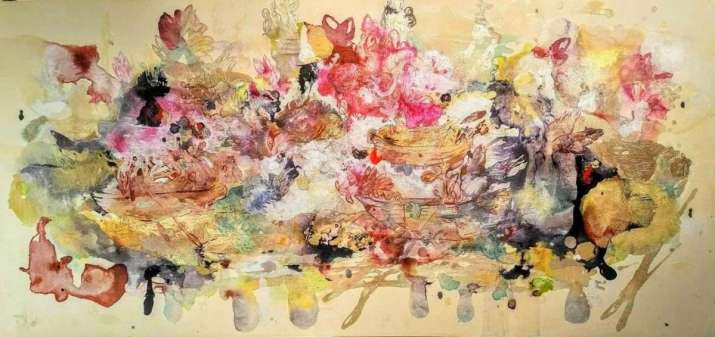
As a child Lowell Boyers loved comic books—the superheroes, their power of flight, and ability to lift mountains! As an adult he has found parallels in the world of the Dharma related to breaking or dissolving boundaries. For Boyers, making art is about boundarylessness.
Trained as an artist at Yale and the Rhode Island School of Design, Boyers was a painter long before he encountered the Dharma. He feels that he might not even have heard the Dharma if he hadn’t already been a painter. When he first heard his teacher, Dzongsar Khyentse Rinpoche, teach it was in a language Boyers could already relate to as he was instinctually in pursuit of similar truths through the avenue of visual art. Observations and expressions he didn’t necessarily have the language to describe or even yet contextualize he now heard spoken aloud.
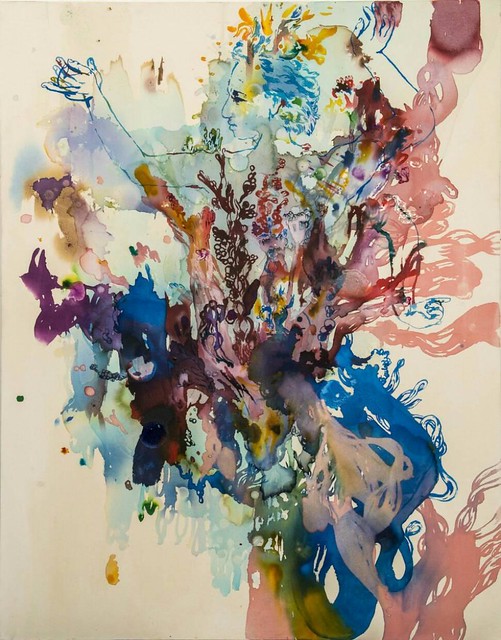
Boyers’ Dharma practice and art inform each other, but he doesn’t necessarily consider himself a Buddhist artist. His work appears dreamlike, ethereal, luminescent. He is very fond of the work of Gustav Klimt, which is highly ornamental. In a way, he feels that the ornamentation inside is showing outside. His own work he describes as inner and outer landscapes—his newest body of work is about the inner landscape, in union with the outer world. He used to also love early Christian Byzantine church art, the gilded, decorative extravagance.
Boyers’ work can elicit connections to Tibetan stories of yogis who could fly (ancient superheroes!) and also a feeling of flying through one’s sensations and feelings, experiencing the vast space of the moment unfolding. Some of the elements of his paintings—their spots or nectar drops—he refers to as “big bangs:” “Each time you have a sensation it’s like a mini big bang where everything is unfolding for a split second—it’s so fast, then boom! It all dissolves. I like portraying these stars or blossoms, becoming explosions, bits, DNA strands, spines, one thing leads to another and another,” and the composition unfolds.*
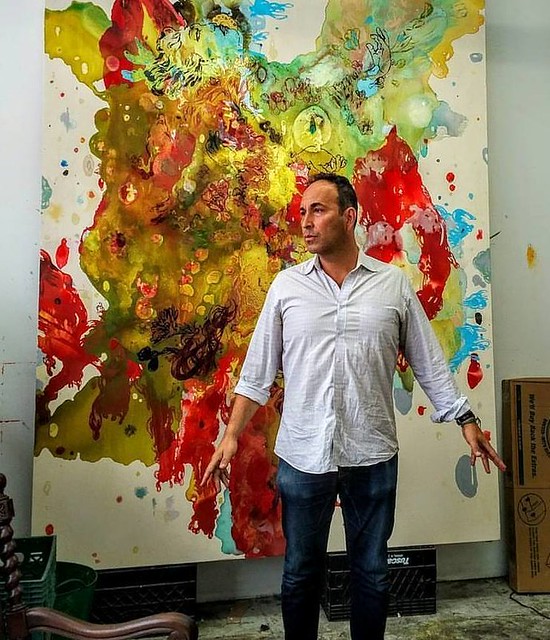
Boyers says that, like many artists, he enjoys the fertile ground of the blank canvas, this sense of opportunity without having to overlay concepts on the appearances of color and form. He can trust the unknown and play in it by manipulating the media in the illusory emergence of appearances. This aspect of creativity can be very close to the experience of practicing the Dharma. This is likely why we see so many creative people who are meditators! Even within the traditions of spiritual art of all faiths, there’s a sense of bountiful creativity, ornamentation, and incredible visual information being presented and expressed.
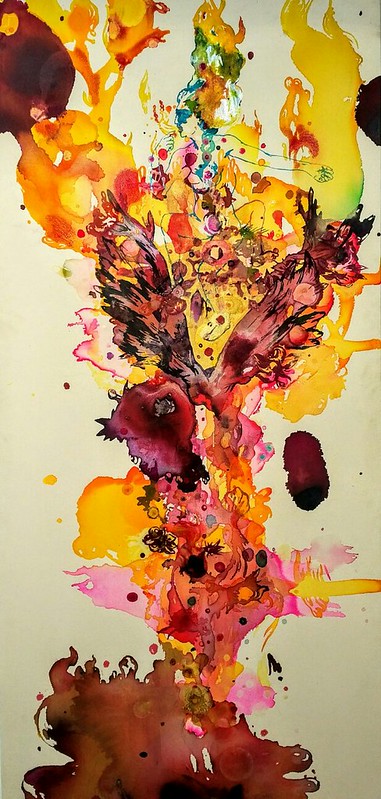
Boyers uses acrylic paint and resin and a lot of water in his work, giving a strong feeling of fluidity and movement in his painting. His process lends itself to this. He used to think of the swirls as vapor, or a vaporousness. He paints a lot of ripples or currents, leading to suggestions of landscapes, boat-like vessels, flowering vessels, and skyscapes. There is a strong feeling of whimsy, movement, and dreamlike imagination. Some recurrent elements are docks, steps, ladders, fences and ladders together, boundaries. A ladder gets you out, while a fence keeps you in, and these paradoxical tensions abound in his work.
Boyers often paints wings, or wings that look like flower petals. In the beginning of a new body of work, he doesn’t know exactly what will happen, but toward the end of a set of pieces—inner landscapes or “intrascapes”—forms and figures emerge from the dreamscape. With the acrylic resin, paint, and coffee grinds, Boyers creates a speckly, textured medium, and his use of metallic paints refers back to early Byzantine works.
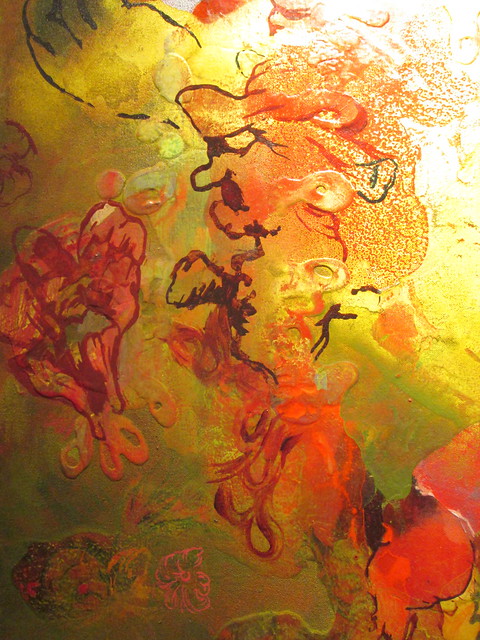
“I use raw canvas like the template of our mind which, before perception, is a fertile but empty ground we fill and dissipate all phenomena into and onto. The void-like emptiness of the material evokes a timeless open space that allows images to emerge from spills of paint and as soon as they emerge I change them . . . evolve them. The images become urgent and immediate, like marks of calligraphy that embody the fresh action of the gesture.” **
Boyers uses no preparatory drawings, he doesn’t know what will be the painting’s top or bottom. He paints flat on a table top, or on sawhorses, sometimes painting on canvas alone, but often mounting the canvas on wood so it can lie very flat, supported. He begins by building up thin, diaphanous veils of color layers. There is an almost animistic and dynamic movement to his process—working through spatial, repetitive, percussive actions. Emerging forms sometimes feel like mountains or spines, moving one way or another, as eventual representational suggestions come into being. Anything figurative usually comes at a later stage, where he’ll then paint into it, around it, to finish the piece.
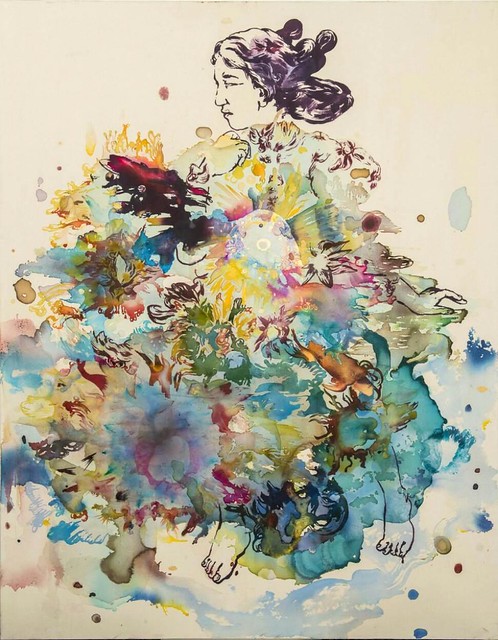
There is a visceral dialogue between a painting and its artist—it comes about like magic. Seeing Chinese ink painters with huge brushes doing calligraphy, is similar to how Boyers paints. Even when mixing paint he doesn’t yet have a specific idea for its use—rather he follows the materials, saves colors, and lets himself be guided by the meditative experience of being in dialogue with the canvas, the color, and the very nature of being alive in this present moment, fully human.
Boyers’ upcoming show of new works will be in May, 2019, at the Deborah Colton Gallery in Houston, Texas.
* Personal interview, 3 December 2018, Manhattan, New York.












